Richard has an inquiry
Our cat is a curious little man.
Perhaps if you like the sound of running water you’ll enjoy this.
My apologies to the earth for the wasted water – VAL was the photographer, not me.
Sometimes I just don’t know what to say.
Our cat is a curious little man.
Perhaps if you like the sound of running water you’ll enjoy this.
My apologies to the earth for the wasted water – VAL was the photographer, not me.
Sometimes I just don’t know what to say.
Last year as I taught the new CHW3M and CHY4U courses I set for myself some personal challenges:
I spent a lot of time with the curriculum document – it’s heavy but it’s all marked up now.
I can’t say that I was fully successful, but I’m proud of the efforts I did make. I took a lot of mental notes on what to change next time.
Here are some pointers I’ve developed to help me keep up the challenge and to communicate to other interested people what I am doing. Note: this PPT changes a lot as I add new things and develop my thinking.
The transition is hard but it’s worthwhile.
Becoming an Inquiry Teacher (Nov. 28 update)
OISE – Jan. 19, 2016
Thanks for attending. Please feel free to email me at risa@cabal.org if you have any questions.
Here are the two parts of my presentation:
Learning to paint has obviously required me to broaden my art education: while I primarily watch painting videos, I have also read a fair amount, not just how-to books. But there is so much to learn still, drawing in perspective, in particular, and sunsets, ironically. The same applies to learning new topics for world history.
As far as being a history teacher, I am currently in the process of educating myself about the history of Africa. This is a large task that is worth taking time to process. In world history it is possible to just “throw” topics at students for them to investigate without knowing much about them yourself. While I like the investigation method, I still think the teacher should have a decent amount of background information. I am not going to teach aspects of African history to my students; they are going to discover and inquire. However, I am the driving force behind this course, so I need to get my driver’s license, so to speak.
In my future video (in progress until my learning is more solidified) I will share why I need to include more African history in my grade 11 world history course and how I might go about putting this into practice.
For now, here are some thoughts about caveats for introducing African topics into world history.
Africa is not 100% missing from my current course but it’s definitely far too sparse. It’s crucially important for all students to understand that our entire species originated in Africa. I have a small section of the paleolithic topic where I use a video clip about forest clearing in West Africa. I include such people as Mansa Musa, Malian ruler, in my middle ages unit. And I have a section on the Kingdom of Kush and its interactions with Egypt. And Egypt, of course, but people should not fool themselves about including African content solely by studying Egypt.
Sounds piddly when I write it out.

Here are some topics I am working on:

So stay tuned as I share my thoughts.
I have so many paint brushes!! I always think the newest brush will solve my painting problems; however, I have learned (the expensive way) that brushes aren’t magical. Although, there are a few specialized brushes that I absolutely love and feel DO make a difference when I match the tool to the job.

In teaching world history, I am certainly NOT the person who wants to use the newest gadgets and technologies. So, in this post, by tools I mean something more like medium or type of activity: Essay or podcast? Group, pair, or solo work? That kind of thing. The most technology I’ve ever used was of course during the pandemic – switching to Google Classroom, for instance, or using jamboards, or Google docs interactively. I’m not a Luddite but I am pretty low-tech.
A word on use of Google Classroom: it’s a great organizational tool, one I can overdo. I tend to load up my GC with resources that I think are helpful. But when I see the way students interact with the GC, I realize that most of my resources are being missed because on GC I focus on the classwork tab; students tend to use the stream. Also, if I were teaching this year, I’d try to rely on GC less. I will do anything to keep students off computers and off their phones. They need to learn to be independent of their mind-altering devices.
Lastly, a word on inquiry. In a post on medium / type of activity, I must make it clear that most of the course is in an inquiry-like style, with as little lecturing as possible. It’s 2023-24 after all!
CHW3M Assignments that Used the Right Tool
Athens Vs. Sparta
Though my course is generally structured around cooperative group learning, there were times during the pandemic when that felt kind of scary. During the first full year of pandemic learning I had two student teachers at the same time (one being virtual, one in person). They came up with a great pair assignment for the Athens vs. Sparta topic. Credit goes to Reilley Kallem and Ellie Leung for pushing forward with this; I was hesitant but it turned out to be a great project.
After learning some basics about both Athens and Sparta (way of life, social structure, some cultural aspects, etc.), the students were to read Pericles’ “Funeral Oration” and Aristotle’s “On a Good Wife” and incorporate one of them into in-role writing between an Athenian and a Spartan of opposite class origins. The creative in-role aspect was that they were assigned very specific social positions – gender and socio-economic status (along with some helpful background information on their positions). They had to come up with a scenario in which their characters would ‘meet’ and discuss one of the primary source documents mentioned above. Also being tech masters, these young teachers made the jamboards look like very cute (and historically relevant) scrolls.

The final pair aspect was that the students had to write an exit ticket in which they critically examined their partner’s in-role writing. I liked that they had to demonstrate what they had learned from their partner, or had the opportunity to note the shortcomings of their partner’s work without complaining about them.
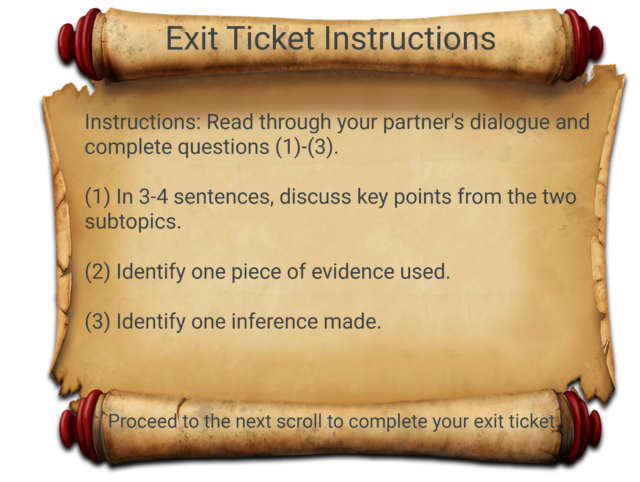
The next year I adapted this assignment back to my original intent (in-role writing but not with quite such specific roles) but kept the spirit of the exit ticket. I allowed students who wanted to work by themselves to do so, but the majority chose to pair up and seemed to enjoy the task. It helped that I wrote an in-role sample for them (using a non-Greek topic).
Indus Valley
My class is generally based on cooperative group learning. When learning briefly about Indus Valley civilization at the start of the course, students worked in groups to examine multiple theories of its decline – a MYSTERY!!! This began as an activity I designed for the CHW3M provincial e-learning course. However, I adapted it heavily to the ACTUAL classroom. Each group was presented with four possible theories of decline and had to consider them and, most importantly, the evidence to support them. In past, I made this an individual assignment that followed upon the group’s assessment of the theories – not very creative. One year, however, I made it an individual follow-up where they could choose to morph the theories if they felt that provided the best evidence-based solution to the mystery. I got some very interesting combinations of theories and noticed that students felt more ownership. Most important for me was that the students began to use what I call the language of probability; they used a version of red light, yellow light, and green light. History is all about interpretation but it needs to be based on evidence.
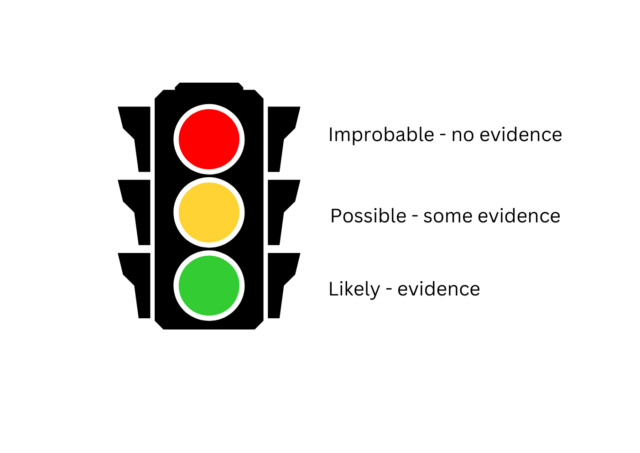
This is also an example of using inquiry style without research. Though research is often a component of inquiry, it doesn’t have to be something that takes a lot of time. That’s why I made summaries of the four theories of decline for the students. They still had to do the work to differentiate between general information and specific evidence to support each theory. In a packed, very broad course such as CHW3M, the teacher has to pick the moments for time- consuming research.
Email Risa if you’d like the Indus Valley assignment. risa@cabal.org
Rome – Not Always the Right Tool
Since I have taught grade 11 World History for nearly 25 years, it goes without saying that I have a lot of versions of assignments. Probably the unit with the most versions is Rome, which, not surprisingly also happens to be the unit with which I am most familiar. As a teacher of world history, I can never know all the content equally. I learn bit by bit, but I am endlessly fascinated by Rome and have read a lot! This would naturally give me a huge Rome unit!
At the same time, however, I have also changed the course over the years to incorporate more societies. So, I had to give up some Rome activities that I really loved, such as one I inherited and turned into a real crowd pleaser: trial of the assassins of Julius Caesar (email Risa if you’d like a copy).
The curriculum has changed a few times since I’ve taught this course, mostly for the best, I believe. I like pairing decline of a ‘civilization’ with the HTC causes and consequences, so I turned one of my old Roman emperor research projects into a competition for best or worst emperor (scroll down to end of page) depending on how much each had contributed to the eventual decline of Rome.
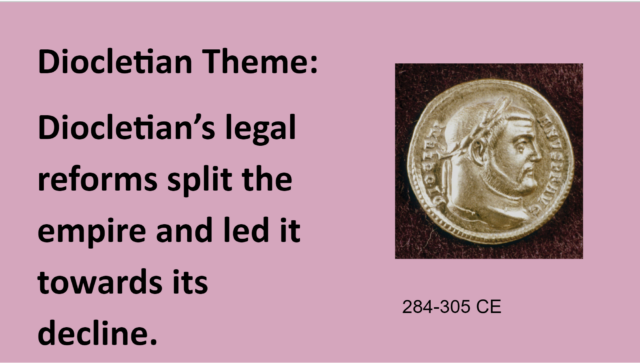
It has been through many iterations but has never quite clicked. Here are a few of the formats I’ve tried:
Competition is actually a very good tool. It works well in my culminating activity but it just hasn’t gelled for this assignment, though I do remember one version some years ago when each group had to come up with a tweet (the “in” social media at the time) about each of their competitors for best or worst emperor. It was FUN! One year I was away at a conference the day the students were writing tweets. I was watching live on Google Slides as the groups entered their tweets. I was laughing out loud during someone’s presentation! Obviously I would not leave them alone to do that these days of fraught social media.
@OptimusPrinceps (Trajan): Hey Hadrian, thanks for keeping the land safe from the barbarians – but you could’ve done more. #expansions #successor
@Trajan stop wasting money on frivolities. Rome doesn’t need to be pretty!
There are a million possibilities for how you could teach something. It’s up to the teacher to try to find the best tool for the job. Your choice won’t always be perfect – it’s okay to take a risk, but it should be thought through.
As a beginning painter I am super self-critical. This often paralyzes me and causes me to take forever to finish paintings. Sometimes I rob myself of enjoyment of this hobby – this seems counterintuitive!
Similarly in teaching, because my time is divided between student success and world history, I have to learn to curb my penchant for self-criticism.
One area where I constantly question if I am doing enough is inclusion of women in history.
Today I’ll examine areas of my CHY4U course that focus on women. October also happens to be women’s history month. Here we go… I’ll put myself under the microscope.
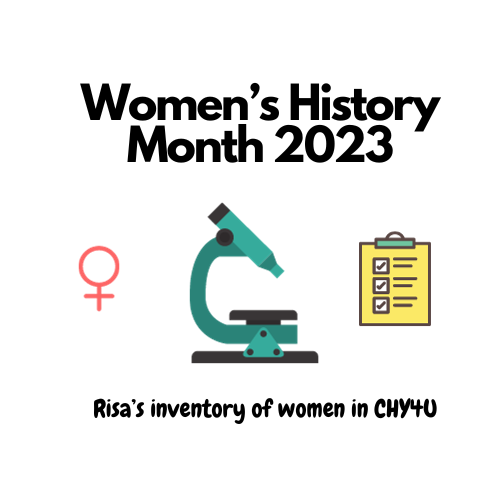
I was provoked to explore the theme of women in my course by a book review I read by Sarah Bakewell in the New York Times Book Review. She was comparing two recent books about George Orwell [1], one being Anna Funder’s Wifedom: Mrs. Orwell’s Invisible Life. Bakewell quotes Funder on her approach to writing about Orwell’s first wife, Eileen O’Shaughnessy:
“I wanted to make her live…and at the same time to reveal the wicked magic trick that had erased her [from previous biographies].”
…
“Biographers of men often do it unconsciously by expressing actions in passive or impersonal constructions, so that houses are rented and furnished, and literary parties are held. Authors’ manuscripts apparently type themselves and edit themselves, or even suggest beneficial improvements to themselves. The women behind these miracles are unnamed and unseen.”
As a world history teacher, I constantly worry that I am perpetuating the disappearance of women from history. Of course history has largely been written by men, meaning women’s voices and experiences have often been omitted. However, this is 2023 and there’s no shortage of information and creative ways to study women.
Even though I want to do my best for students, I cannot spend my entire life revising my courses. So, I decided to do an inventory of women in CHY4U and to focus on one or two assignments that I can improve on an ongoing basis (not all of them!).
Inventory
In unit one (“what were they thinking?”, 1450-1650), women are included here and there. The one woman who gets more attention is La Malinche, the Indigenous translator for Spanish Conquistador Hernan Cortes in Mexico. She makes for a very interesting subject precisely because there isn’t actually a huge amount known about her, especially in her own words. What was contemporaneously written about her of course was by men. Through historiography, students can come to appreciate the ways historical portrayals of women change over time – she has been variously seen as a traitor and a hero and everything in between.
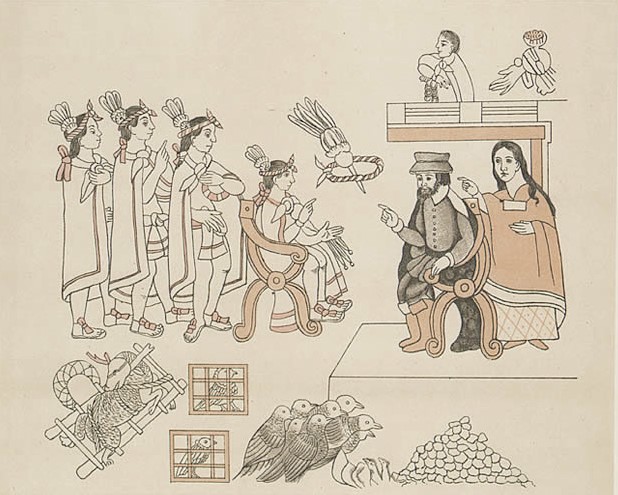
I also used to have a very good activity on Malleus Maleficarum, the Hammer of Witches (1486), a very significant book about sorcery which was intended to be used by Catholic Church inquisitors in their work seeking out and prosecuting such supposed heretics, especially uneducated women. This lesson helped students understand the crucial context of the Christian doctrine of original sin [2] and its egregious biases toward women. Unfortunately, I omitted this topic a few years ago to make room for more decolonized materials.
In the culminating activity for unit 1 (Global Gathering) I currently include only one woman as a topic choice – obviously that has to be remedied. Please check out this video about this assignment as it is one of my favourites and it can be easily updated!
Don’t forget to watch the VIDEO!
Unit 1 curriculum expectations relevant to women are: B1.1, B3.2
In unit 2 (“what was worth fighting for?”, 1650-1789) I added an opportunity to learn about a non-western woman – Roxelana – who was the wife of Suleiman the Magnificent. Living in the 16th century she obviously doesn’t belong in this unit; however, here’s how I justify her inclusion: I created a lesson to follow up on the western enlightenment that questions whether Europeans had a monopoly on so-called enlightenment. In this lesson students inquire into the lives of Akbar the Great and Suleiman. I suppose seeing Roxelana as an added bonus is not really appropriate. She should be more front and centre. I think it’s fair to be self-critical here; despite my intent, I could be sending the wrong message.

In this unit I also introduce students to the origins of industrialization and thus to women working in cotton mills and coal mines. I have discovered over the years that many students don’t understand that women have always worked. Despite it being 2023, some students still come to world history with a naïve view of women not working outside the home until recently. However, I have once again significantly reduced this topic over the years to make way for more non-western content in the course.
Unit 2 curriculum expectations relevant to women are: C1.1, C1.2, 2.2
In unit 3 (“What Re-Shaped the World”, 1789-1900) I feel there’s more emphasis on women. Firstly, in the French Revolution lessons I have a whole section devoted to women. I have deliberately chosen to make it the last lesson within the revolution topic. After learning how women didn’t receive the same rights as men (though they of course still fought for them), students get to tell me if they think the female aspect should be integrated into the topic as a whole or kept separate. Year after year students tell me it has more impact being separate (as I intended). We examine a primary source document by Olympe de Gouges. Last year my students did an incredible job analyzing.
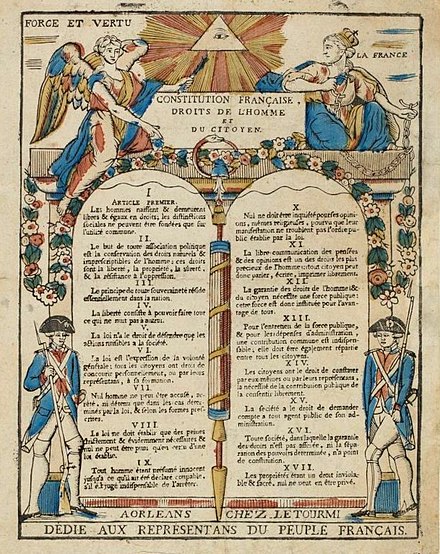
Also in this unit I have a lesson on the 19th and early 20th century fight for women’s suffrage and step by step modernization of social and economic status. It’s pretty western-oriented, however, I feel it’s very important for students to once again recognize that some of the challenges women faced back then have still not been fully addressed. Because the lesson is based on a timeline of key events it is easily updatable.
Unit 3 curriculum expectations relevant to women are: D1.1, D2.3, D2.5
Here I should say that units 3 and 4 of the course really overlap. As we all know, as we get closer to the end of the course, the focus becomes the course culminating activity. I personally find that the last unit really takes a hit because of this.
In unit 4 (“Are We Any Better?”, 1900-present) I feel there’s a good emphasis on women. Last year, as a bridge between units, I added a lesson called “social movements for equity” that allowed students to research various LGBTQ2+ -related topics to make a more inclusive timeline of recent world history. It still needs more work, but it is a start. I chose four sub-topics and gave starting sources for each: current rights around the world; Nazi Germany; Canada during the Cold War; colonization. The impetus for this assignment was that our school hosted the TDSB’s International Day of Pink celebrations last year and we were all asked to create aligned lessons. I am very glad I was pushed to make this change and am happy to report the feedback was quite positive.

The last assignment in my CHY4U course is “Feminism Comparison.” Here students make a comparison between Chinese and American women – given two timelines – and have to decide whether Chinese or American women’s lives have changed more. It’s an easy assignment for me to update yearly (if I remember!) because I made the timelines myself and can simply do more research to add to each. It also ties into industrialization and globalization themes nicely.
Unit 4 curriculum expectations relevant to women are: E1.1, E1.2, E3.3
Reflections on the Inventory
Seeing this inventory could push me into a deep pang of self-criticism because of the apparent gaps. However, that is not the purpose of the inventory. I’m supposed to be self-critical only to a point. With the course being inquiry-based, it is not difficult to add opportunities for students to explore other women. The difficulty is in finding the time and deciding what to cut.
The incredible scope of time and place is obviously one of the greatest challenges of teaching world history. But women are worth it!!!
[1] Sarah Bakewell, “Mr. and Mrs. Orwell.” Review of two books about George Orwell. New York Times Book Review. September 16-17, 2023.
[2] See this webpage from the British Library, “Women in Medieval Society.”

When painting I often get so caught up in tiny details that I don’t step back and look at the whole painting (apparently that is what easels and long-handled brushes are for). This makes me very obsessive, and I miss the big picture.
The same has often happened in teaching. Sometimes when I’m fussing over the details of a lesson or resource, I miss an opportunity.
Last year I corrected one of these omissions by adding more Canadian topics into unit 2 (1650-1789 – What was worth fighting for?) of my grade 12 world history course. I came up with the ideas for topics and my then student teacher, Florence Marti, created the lessons focusing on the Hudson’s Bay Company as a driver/facet of colonialism. This addition to the course was inspired by a book I read about New France in the 1600s by Mairi Cowan. After all, and as Mairi shows in her book, Canada is and was part of world history.
I now see another opportunity that I had not taken in the past. In the same unit under the topic of the trans-Atlantic slave trade and enslavement of people in the New World, I have a lesson on some excerpts from the Code Noir – the laws regulating lives of enslaved people in French colonies. I’ve always had students look at this document within the Caribbean context. Why have I not seized the chance for them to learn more about Canada here? Now that I am, continue reading below and/or watch this video to see my process for changing my approach.

Code Noir
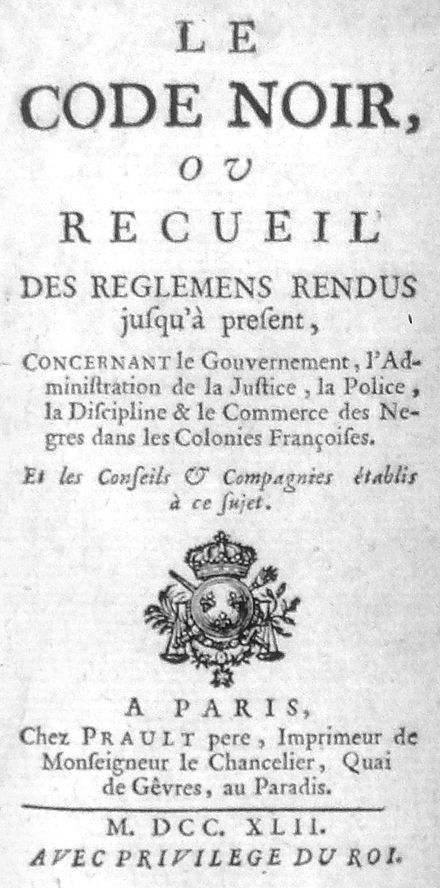
The Code Noir apparently applied in New France. The sources I have consulted are not entirely clear about the extent, but they make it clear that it existed in New France (see Canadian Museum for Human Rights).
According to Afua Cooper, Canadian author and historian, the first instance of an enslaved person in Canada goes back to 1628. Cooper says it was in 1689 that the Code Noir came into force in the colony[1].
I first started using “Code Noir” as a primary source excerpt back in 2002 because it was in the Haberman textbook (sometimes convenience is good!), and it fit in the unit that included the topics of slavery and resistance. It’s the perfect foil for the enlightenment topic as well: the enlightenment is a paradox.
So much has changed over the years in approaching topics such as slavery. First of all, the terminology we use: slavery vs. enslavement; slave vs. enslaved person. I have included a discussion of terminology in my world history class for a number of years as my own awareness of the way we teachers shape our students’ perspectives knowingly and accidentally has grown. That’s why the resistance topic has always been very important to teach. As Florence noted in her lesson, we need to be aware of how commodification and objectification of people can be implied through the way we use language and in the ways we frame lessons.
So why exclude Canadian history from this approach?
Here are the first two lessons of the slavery and resistance topic.
CHY4U Unit 2, Activity 2 (Slavery and Resistance)
2 Classes of 70 minutes each (2 more for Haitian Revolutions not included here)
Materials
Lessons
Day 1
Minds On
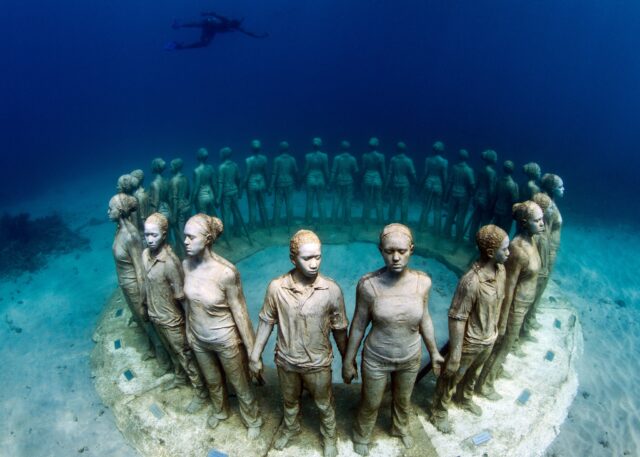
Have Vicissitudes under-water sculpture showing on the title page of the slides (note, the sculptor did not intend for it to represent victims of the slave trade, but it has been interpreted by MANY people to mean that).
Also, trigger warning for today’s topic – may be traumatizing for some. It is a very horrible topic to learn about but extremely important.
Read excerpt from “Slave Ship” to set the mood (usually I read the first few pages – the forced and harrowing journey of a captured woman from the interior to the slave ship).
Have students watch the interactive map of the trans-Atlantic slave trade and come up with inquiry questions using the question grid. I usually show the map many times and ask students to stop and notice certain trends (e.g, change in pace and number of ships, change in destinations). Emphasize that these are not just dots on the map. Each ship held captives – real people. If you click on the dot you can see how many people were aboard each ship and where it was destined for.
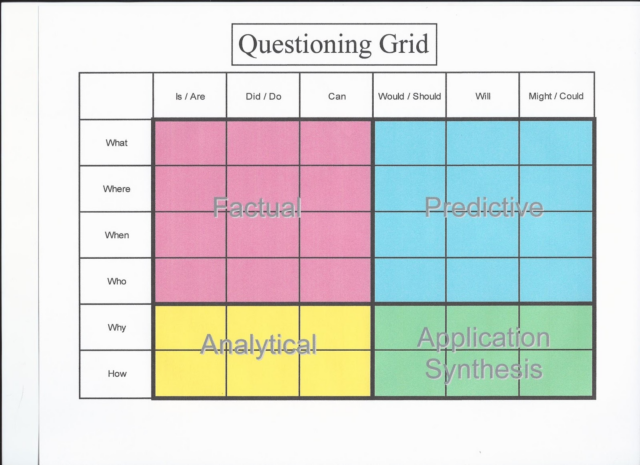
Action
Continue slides to get the gist of how the trade worked. Ask students to corroborate (confirm) by picking out details from Slave Trade notes that correspond. Students work in groups to be able to discuss and develop selection criteria.
Remind students that this is not just a story of people who were stolen and then just accepted their fate. People resisted in many ways (reminder of unit question – what is worth fighting for). Have students read pages 108 to 111 in the textbook and take notes on methods of resistance. This is a very important way of de-emphasizing objectification. Though of course enslaved people were victims, they were humans first.
For day 1 follow-up, students are to categorize those methods of resistance: don’t give students all the categories – maybe one example such as spiritual. Some very thoughtful comments usually happen in the brief take-up at the start of the next day when students discuss the vast array of ways that enslaved people resisted.
Day 2
Minds On
Pick a quote from Code Noir and read it to class without mentioning where it’s from (3 possible examples below).
5. We prohibit our white subjects of either sex from marrying blacks, on pain of … punishment and fine…
8. All children born from marriages between slaves will be slaves….
27. Verbal excesses committed by slaves against free people will also be punished with death.
Ask if anyone thinks they know what it is referring to? In what kind of PSD would this be found?
Once ascertained, ask: Does the Code Noir seem surprising in a lesson in the same unit as the enlightenment? Remind students of previously learned enlightened characteristics. They will be contrasting with the code with these supposed characteristics.
Background info: Enlightened Characteristics taught in the previous lesson
Action
Introduce the PSD for today, Code Noir, the French law code that regulated the lives of enslaved peoples and those they interacted with in their colonies.
This applied in Quebec as well – yes, there was slavery in Canada.
Ask students:
Each group is to work through the Code Noir worksheet using the PSD on page 108 of the textbook. The chart also asks students to contrast the Code Noir with enlightened characteristics as a reminder that the enlightenment was a paradox.
Consolidation
At the bottom of the chart there is this fill in the blanks: See if groups can get it. To what extent does it sum up the colonial attitude toward enslavement? Perhaps groups can do better and come up with their own summation.
Hints:
control of religion and family structure; perpetuation of the institution of slavery through procreation based on a belief that blacks were inferior .
For HW, students can do follow up questions for Day 2.
[1] Afua Cooper, Slavery in Canada, Ontario Historical Society website, https://ontariohistoricalsociety.ca/wp-content/uploads/2020/06/slavery_in_canada.pdf
Video (Risa shares her process)

Starting with my strength! In art as in music as in lesson planning, one must repeat, repeat, repeat.
When I first started teaching grade 11 world history back in 1999, I was literally a few pages ahead of the students in the class. I had not taken any world history since high school – and even that was very limited as the teacher had a rather narrow view of what should be taught (western, Christian civilizations).
Interestingly for me, many of my students were members of the classics club at the school and were very keen; though mostly they could recite things in Latin and/or Greek and knew a lot of trivial pursuit factoid types of things. That didn’t help me much.
I had no choice but to dive in. I started reading a lot and using the resources at hand. Our library had a great collection of world history books. Yes, actual books. I also watched a lot of history-related shows on PBS, especially relating to Greece and Rome.
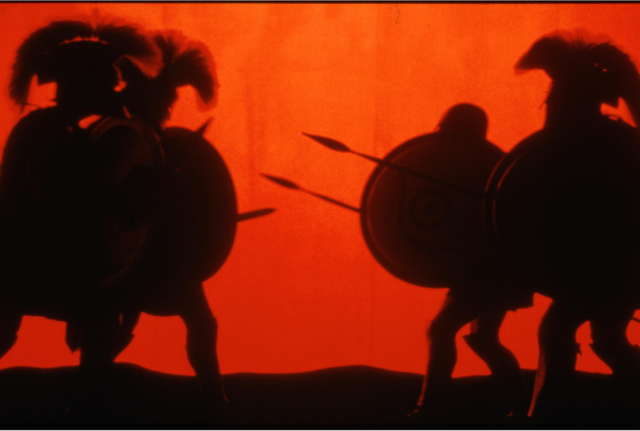
Since I was also teaching Canadian history and grade 12 “modern western civilization” at the same time, my saving factor became lesson planning. Organization has always been one of my best teacher skills, not so much a skill I possess in my personal life. Odd.
Thankfully I inherited a small collection of materials from the previous “ancient” history teacher. After weeding through it for things I liked, I had a sense of what came before me – not that I wanted to copy it wholesale. That’s not my way. I usually do like reinventing the wheel.
I made myself a lesson planning template and started planning units, tests, and then individual lessons. For me, the skill that needs the MOST practice in teaching is lesson planning. I find that almost right out of the gate, new teachers stop planning their lessons. When I host student teachers (teacher candidates, more precisely), they sometimes seem surprised that I want to see detailed lesson plans from them on a daily basis.
Anticipating how things will go is a big plus! These days I cannot imagine how anyone could teach without planning. Lessons need to keep moving swiftly as kids lose interest very quickly, sometimes instantaneously if you can get their interest at all.
Even after 20+ years I still write some lesson plans. When I was going on a short medical leave last year I wrote lessons for all the grade 12 world history classes I’d miss which ended up being the whole course because of surgery postponement!!
One might ask if lesson planning is a facet of creativity at all? I believe it is. It is in the planning where a new or experienced teacher comes up with an idea to make a topic interesting. In history that could be a trial, a role-play, a simulation, a short activity, or as we say today, a minds on. I admit that some of my most creative activities come to me spontaneously in the classroom. However, I don’t think my creativity would be able to kick in if the cognitive load had not already been reduced by doing so much planning.
My Most Creative Plan
Looking back is hard for me because – ironically – I have a bad memory. That’s bad for a history teacher, but it doesn’t usually affect content. Just events, names, faces in my OWN life. That said, one activity I developed on the topic of Hammurabi’s Code really stands out. The students first analyzed the document (okay, not all 282 laws) looking for ways that specific laws affected different groups of people in society – farmers, merchants, women, the king! They were divided into different groups based on roles on society and each had to come up with either a law they wanted to keep – and the justification for that – or the law that they wanted to ‘amend’ and their proposed revisions. They would then present to the king and his advisors – roles played on a rotating basis by each group of students. The kids would always love in-role activities. Sometimes they got so into it they sent out spies to check on the other groups. I remember it even getting it slightly out of hand as they tried to maintain secrecy until the final reveal of their scripted encounter with the king. Then of course there was always the moment when the king decided if he wanted to punish them for their suggestions!
Did I plan this? Well, I didn’t plan for all the offshoots such as spies and secrecy. But I planned the activity to such a degree that the kids had the freedom to give it a life of their own.
I don’t do this activity anymore for a number of reasons but mostly I am more cautious with role-plays now as I am much more mindful of presentism and the need for students to asses how probable (or not) it would have been for people to think a certain way. On the whole I am much more of an inquiry-based teacher now. However, I still find room for some role-plays such as my Black Death simulation.
Art Parallel
Now, do I practice enough in art to help develop my skills? Because I don’t paint on a daily basis I would say no. This usually results in me overthinking what I should do next because I don’t have a plan. Ultimately, my potential creativity and skill development are hindered before they even got out of the gate.
Having a sketchbook where one can practice is akin to writing a lesson plan. I definitely use my sketchbook. However, I don’t always follow through with a “good” copy, so to speak.
For Teachers
Get yourself a lesson template. In world history, use it to plan the societies you will include in the course, either through direct instruction, group work, or student inquiries. It’s very important to make sure the course is diverse and ever changing.
I use a template such as this to make my plan for what I will teach in a given semester.
This is the first in a series. If you’re not sure what you’re looking at, watch this short intro to my “For World History Teachers” year-long project (2023-24).

Starting with my strength! In art as in music as in lesson planning, one must repeat, repeat, repeat.
When I first started teaching grade 11 world history back in 1999, I was literally a few pages ahead of the students in the class. I had not taken any world history since high school – and even that was very limited as the teacher had a rather narrow view of what should be taught (western, Christian civilizations).
Interestingly for me, many of my students were members of the classics club at the school and were very keen; though mostly they could recite things in Latin and/or Greek and knew a lot of trivial pursuit factoid types of things. That didn’t help me much.
I had no choice but to dive in. I started reading a lot and using the resources at hand. Our library had a great collection of world history books. Yes, actual books. I also watched a lot of history-related shows on PBS, especially relating to Greece and Rome.

Since I was also teaching Canadian history and grade 12 “modern western civilization” at the same time, my saving factor became lesson planning. Organization has always been one of my best teacher skills, not so much a skill I possess in my personal life. Odd.
Thankfully I inherited a small collection of materials from the previous “ancient” history teacher. After weeding through it for things I liked, I had a sense of what came before me – not that I wanted to copy it wholesale. That’s not my way. I usually do like reinventing the wheel.
I made myself a lesson planning template and started planning units, tests, and then individual lessons. For me, the skill that needs the MOST practice in teaching is lesson planning. I find that almost right out of the gate, new teachers stop planning their lessons. When I host student teachers (teacher candidates, more precisely), they sometimes seem surprised that I want to see detailed lesson plans from them on a daily basis.
Anticipating how things will go is a big plus! These days I cannot imagine how anyone could teach without planning. Lessons need to keep moving swiftly as kids lose interest very quickly, sometimes instantaneously if you can get their interest at all.
Even after 20+ years I still write some lesson plans. When I was going on a short medical leave last year I wrote lessons for all the grade 12 world history classes I’d miss which ended up being the whole course because of surgery postponement!!
One might ask if lesson planning is a facet of creativity at all? I believe it is. It is in the planning where a new or experienced teacher comes up with an idea to make a topic interesting. In history that could be a trial, a role-play, a simulation, a short activity, or as we say today, a minds on. I admit that some of my most creative activities come to me spontaneously in the classroom. However, I don’t think my creativity would be able to kick in if the cognitive load had not already been reduced by doing so much planning.
My Most Creative Plan
Looking back is hard for me because – ironically – I have a bad memory. That’s bad for a history teacher, but it doesn’t usually affect content. Just events, names, faces in my OWN life. That said, one activity I developed on the topic of Hammurabi’s Code really stands out. The students first analyzed the document (okay, not all 282 laws) looking for ways that specific laws affected different groups of people in society – farmers, merchants, women, the king! They were divided into different groups based on roles on society and each had to come up with either a law they wanted to keep – and the justification for that – or the law that they wanted to ‘amend’ and their proposed revisions. They would then present to the king and his advisors – roles played on a rotating basis by each group of students. The kids would always love in-role activities. Sometimes they got so into it they sent out spies to check on the other groups. I remember it even getting it slightly out of hand as they tried to maintain secrecy until the final reveal of their scripted encounter with the king. Then of course there was always the moment when the king decided if he wanted to punish them for their suggestions!
Did I plan this? Well, I didn’t plan for all the offshoots such as spies and secrecy. But I planned the activity to such a degree that the kids had the freedom to give it a life of their own.
I don’t do this activity anymore for a number of reasons but mostly I am more cautious with role-plays now as I am much more mindful of presentism and the need for students to asses how probable (or not) it would have been for people to think a certain way. On the whole I am much more of an inquiry-based teacher now. However, I still find room for some role-plays such as my Black Death simulation.
Art Parallel
Now, do I practice enough in art to help develop my skills? Because I don’t paint on a daily basis I would say no. This usually results in me overthinking what I should do next because I don’t have a plan. Ultimately, my potential creativity and skill development are hindered before they even got out of the gate.
Having a sketchbook where one can practice is akin to writing a lesson plan. I definitely use my sketchbook. However, I don’t always follow through with a “good” copy, so to speak.
For Teachers
Get yourself a lesson template. In world history, use it to plan the societies you will include in the course, either through direct instruction, group work, or student inquiries. It’s very important to make sure the course is diverse and ever changing.
I use a template such as this to make my plan for what I will teach in a given semester.
Panorama Theme by ![]() Themocracy
Themocracy